The Natural History Museum is one of the most popular world-class tourist attractions in the United Kingdom. This science research center is home to 80 million specimens! If you’re wondering how to get there and what to see & do, keep reading this comprehensive guide to visiting the Natural History Museum London in 2024.
How To Get To Natural History Museum London, UK?
Natural History Museum is located at Cromwell Road, South Kensington, London. From our places (Pimlico & Acton), it took almost 10-15 minutes to reach the museum by car. They do not have parking facilities on-site, and parking around the museum is limited.
South Kensington is the nearest tube station. However, you can avail of buses as well. There are several bus routes that stop near the NH museum.
Address:
Cromwell Road, South Kensington
London SW7 5BD
A Visitor’s Guide to Natural History Museum London – The Facilities:
We visited the Natural History Museum twice to date. It is considered one of the three major museums in the South Kensington area, and the other two are the Science Museum and the Victoria and Albert Museum.
There are three entrances to this museum – Queen’s Gate, Cromwell Road (step-free entrance), and Exhibition Road.
The Natural History Museum is vast in structure. We were smitten with its beauty straight away!! Its impressive decorative detail and architecture will surely blow your mind away!
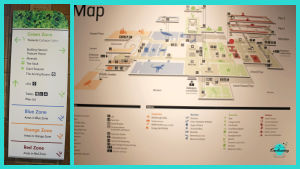
This museum is divided into four color-coded zones -orange, blue, green, and red. It makes the navigation process super easy, and you can complete each zone at your own pace without being confused. Every section again features several galleries comprising various unique exhibits.
Apart from the galleries, this museum also offers facilities like a cloakroom, baby care room, cafe, restaurant, shops, water bottle refill point, clean toilets, picnic area, Centre for UK Biodiversity, and temporary exhibitions (paid). There are plenty of seats dotted around the museum. So you can easily take a rest in between your museum tour.
The museum zone map is like-
Queen’s Gate entrance – Orange zone – Blue zone – MIDDLE Hintze Hall (Cromwell Road entrance) – Green zone – Red zone (Exhibition road entrance).
If you enter through the main Queen’s Gate entrance, the Red Zone will be the last zone of your visit or vice versa!
ALSO READ: Top 7 Coolest Places to visit in the UK in winter 2023
Is Museum Entry Free?
Yes, admission to the Natural History Museum is absolutely free. However, you need to pre-book a slot online to view the museum. You can also donate money to support the museum online at the time of your ticket booking or directly at the center.
How long does it take to see all the exhibitions at Natural History Museum London?
For us, it took about 6-7 hours to see most of the highlights at the museum. Kindly remember that a few exhibition galleries were closed during our visits. So, if you plan to see all the exhibitions and want to have refreshment breaks, it’ll take a day at least to explore the museum.
If you like to read all the information about the exhibits at the museum, it may take longer. If you are a blogger/YouTuber (like me) who loves to read every specimen detail but, at the same time, have to take decent photos and videos, then make sure you have plenty of time on hand to explore this museum. However, if you just want to see the best exhibits on display and walk around the museum, 3-4 hours will suffice.

When Is The Best Time To Visit The Museum?
I would highly suggest visiting this museum in the morning time. We booked an early morning 10.30 a.m. slot. At that time, the museum was less crowded. But by noon, it was totally jam-packed. If feasible, visit this museum on weekdays, not weekends!
Can you buy tickets at the Natural History Museum?
Yes! Tickets are available at the Natural History Museum ticket windows.
Is photography allowed in Natural History Museum, London?
Yes, it’s allowed for personal use. You cannot use tripod, only hand-held cameras/phones are allowed. I carried my selfie stick and did all the photo and videography inside the museum.
To know about their commercial filming and photography rules, please visit their official site.
Can you bring water into the Natural History Museum, London?
Yes, you can!
ALSO READ: Park Plaza Victoria London Hotel Review
Things To See & Do At Natural History Museum, London:
Our visitor’s guide to Natural History Museum is incomplete without giving you some tips on what things you must see and what you can ignore if you are running short of time! However, let me start this museum tour guide with my personal experience first. When we visited The Natural History Museum for the first time, the main entrance (Queen’s Gate) was closed. So we had to enter the museum via the Exhibition Road entrance. After a few months, when I revisited the museum to see the nation’s favorite Dippy, the dinosaur, we entered via Queen’s Gate.
Our cab driver left us in front of the Victoria & Albert Museum. Hence, we walked a few steps along with other visitors to reach the museum. Lucky us, the queue wasn’t long. Thus, after showing our online tickets to the security staff, we entered the museum happily.
As we entered via the Exhibition Road entrance, we encountered the Red Zone first. Spanning three floors (ground, 1st and 2nd level), the Red Zone features everything about our planet, Earth. The galleries include- Earth’s Treasury, From the Beginning, Human Evolution, Lasting Impressions, Restless Surface, Volcanoes & Earth Quakes.
The exhibits in these exciting galleries will stimulate an understanding of the earth’s materials, properties, and processes. Metals and minerals extracted from the earth are the basis of many products used in everyday life. Understanding the earth is central to the responsible management of its precious resources.
You cannot miss out on the giant Stegosaurus fossil skeleton, which is located right at the Earth Hall, Red Zone, Exhibition Road entrance. It definitely makes for a perfect spot for photographs/selfies!
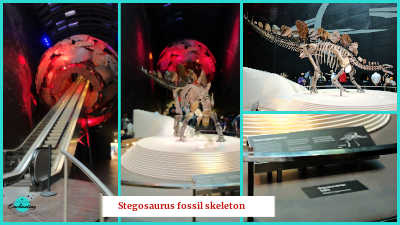
There is a shop named ‘The Cranbourne Boutique’ where you will find plenty of museum-inspired gifts for kids and adults. I liked the gems and beaded jewelry pieces. I got two natural lip balms and a few stones from the store.
The Kitchen restaurant is located right in the Red Zone and offers a range of drinks and snacks. On the same level, you will find the Coffee House. If you want to get a Museum map, pay £1 and get it from the outside of this Coffee House.
To visit the top-level galleries of the museum, you can take the stairs, lifts, or the escalator service. The red-colored, vibrant, giant metallic globe in the shape of earth looks absolutely stunning! It gives you the feeling of entering the planet. You’ll also notice a celestial map on the gallery walls alongside gems, minerals, and a moon rock. Isn’t it cool?
The Earth Hall escalator will take you directly to the second floor – Volcanoes & Earthquake and Restless Surface galleries. The globe looks so beautiful when viewed from the second floor.
ALSO READ: 6 top-rated passport holders and travel wallets in 2023
In the Volcanoes and Earthquake gallery, you’ll get to see exhibits like lava bombs, volcanic glass hair, and crystals created under intense pressure beneath the earth’s surface, heat-resistant suits, and equipment used by scientists, historic seismographic equipment, an earthquake stimulator showing what it was like during the 1995 Kobe, Japan earthquake, a volcano and earthquake locator, interactive games, building techniques to guard against earthquake damage.

On the same floor, in the Restless Surface gallery, you’ll learn how the giant stalagmite was formed, how rivers formed, and how wind, water, and air currents shaped the planet Earth. You’ll explore exhibits like a tombstone sundial, minerals borne from the sea, frozen lightning captured in the desert sand, the ancient life that makes up limestone, and interactive displays showing how wind and water can turn sand into waves.
If you take the stairs down to the first floor, you’ll find From The Beginning gallery and Earth Treasury.
In “From the beginning” gallery, you’ll discover early sea creatures, mammals, dinosaurs and ancient fossils, learn how our solar system was formed, variety of life that’s lived on Earth, 3,500 million year old microfossil that represent the earliest life on Earth, evidence of flying reptiles and dino-birds, early whales, horses, bats and primates that thrived after dinosaur extinction, and the animal species that humans have helped drive to extinction! To sum up, you’ll explore the evolution of life on planet Earth in this gallery.
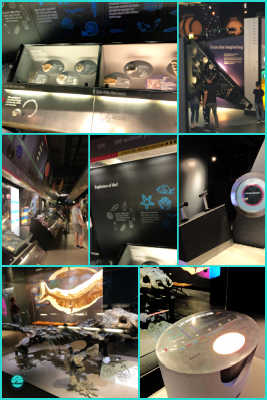
The Earth Treasury gallery tells the story of the Earth planet and solar system, including moon rock, precious metals, and fluorescent minerals. Here, you’ll explore gemstones, minerals, and rocks. You’ll learn how precious stones like diamonds are formed and cut and examine their royal links. You’ll find a rainbow of gemstones and a collection of rings, mineral marvels that glow in the dark, ancient and modern uses of metal, common granite, and rare platinum, different mineral structures from hair-like to prismatic and globular, and all that glitters with gold, diamond, sapphire, ruby and emerald specimens.

On the ground floor, you’ll find the “Human Evolution” and “Lasting Impression” galleries.
In the Human Evolution gallery, you will see some amusing real-life skeleton exhibits such as Gibraltar 1 skull (the first adult Neanderthal skull), life-size Neanderthal and early Homo sapiens models, 3.5-million-year-old Laetoli canine, the oldest hominin fossil in the Museum’s collection, skull and hand casts of the recently discovered human species- Homo naledi, 420,000-year-old Clacton spear, the oldest preserved wooden spear in the world, and Cheddar Man skeleton and model head reconstruction with fascinating insights into the cultural practices of early modern humans in Britain, including a human skull-shaped into a cup.

Don’t forget to look at the 3,500-kilogramme Cranbourne meteorite on your way to the Lasting Impressions gallery.
In the Lasting Impressions gallery, you’ll see some unique exhibits and fossil evidence of past (million years ago) events. From Dinosaur footprints, a calcareous deposit called the Sunday Stone, lichens that can survive for up to 10,000 years, to bamboo that grows a meter a day, 200-million-year-old wave ripples on beach sand, a petrified tree stump, and a giant ammonite, all these exhibits are interesting and fascinating.
ALSO READ: 5 Best Travel Adapter Converters of 2023
After covering the Red zone, let’s move to the Green zone, which includes galleries like – Birds, Creepy Crawlies, East Pavilion, Fossil Marine Reptiles, Giant Sequoia, Investigate Centre, Minerals, The Vault, Waterhouse Gallery and Nature’s Treasure House, etc.
In the Birds gallery, you’ll see the cases of nesting birds (blackbirds & storm petrels) dating from 1883, hummingbirds, two passenger pigeon specimens, framed prints from John James Audubon’s famous The Birds of America book, a beautiful painting of the extinct great auk, an extinct dodo, a Victorian avian anatomy display, an Archaeopteryx fossil cast (you can find the original version in the Treasures gallery) and a number of rare and common beautiful birds.
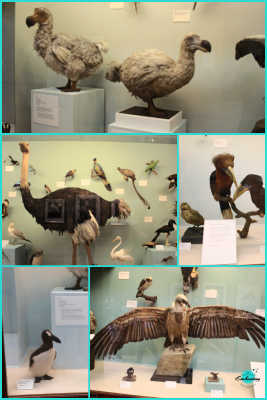
Now follow the signs and enter the Creepy Crawlies gallery, where you’ll find a life-size model of a termite mound, a cabinet of insect life, an interactive game to build a spider, examples of insect communication methods, etc. Learn about the cycle of insect life, centipedes, spiders, and all things arthropods in the Creepy Crawlies gallery.

The Fossil Marine Reptiles gallery features – fossils of prehistoric sea animals (including ichthyosaurs and plesiosaurs), specimens collected by paleontologist Mary Anning and her brother Joseph in the early 1800s, Jurassic crocodiles that lived in the sea, and a giant ground sloth exhibits! Mary Anning’s brother Joseph found the skull of the ichthyosaur Temnodontosaurus platydon in 1810, and Mary found parts of the neck a year later.

In the same vicinity, Dippy’s gallery was located! Currently, this exhibition is closed. But in the future, if the UK’s favorite Dinosaur returns to the NH museum again, don’t miss it. The 26m (85ft) Diplodocus exhibit is a plaster-of-Paris replica of a Diplodocus carnegii skeleton. The dimly lit room was full of tourists when we visited, and why not? The Dinosaur exhibit looked stunning.
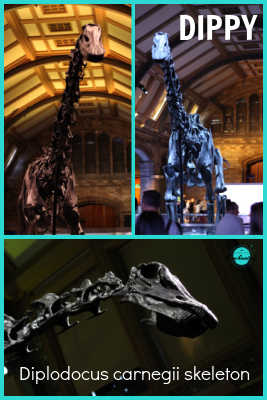
Although the Giant Sequoia specimen comes under the museum’s Green zone, you can spot this exhibit (part of a giant sequoia tree) on the upper second floor of the Natural History Museum. You can get a splendid view of the Hintz Hall from this floor and marvel at the beautiful paintings on the ceilings. Giant sequoias are considered among the largest organisms in the world, and this specimen has been in the museum since 1893.
ALSO READ: Christmas at Kew 2022 Festival, London | Things to see & do
As I said earlier, the Natural History Museum is enormous. Hence, you’ll need to either follow the signs to cover each zone one by one or casually walk along the galleries and marvel at the displays.
The Investigate center is in the Green Zone on the Lower Ground Floor. Since the Waterhouse Gallery and Investigate Centre were closed on the days of our visits, we went straight to the Minerals and Treasure galleries.
It is said that the Minerals Gallery has remained virtually untouched since the museum opened in 1881! In the Minerals gallery, you’ll come across sparkling gem exhibits alongside ornamental mineral art, namely, a 635-kilogram iron meteorite that fell in Argentina in 1783, a 9,381-carat flawless blue topaz gemstone, examples of mineral use and how they were formed, from circuit boards to matches and toothpaste, a wall display of meteorite specimens and the Vault, which contains the Tissint meteorite. It is the largest Martian meteorite in the museum and a piece of the Winchcombe meteorite.
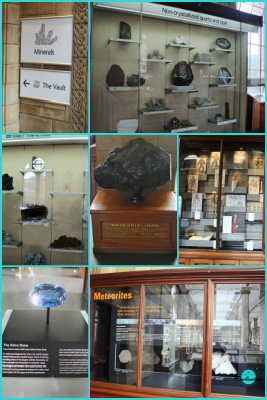
The Vault gallery also features the Anastasia Diamond, an impressive 93-carat black diamond, on loan until October 2022, the Aurora Pyramid of Hope, an unrivaled collection of 296 colored diamonds, the Devonshire Emerald, one of the largest and most richly colored emeralds ever found, a diamond-encrusted snuff box commissioned by Russian Tsar Alexander II, etc. Overall, the world’s largest collection of colored diamonds, rare meteorites, and valuable treasures is on display in the Vault gallery. So, do not miss out on this one!
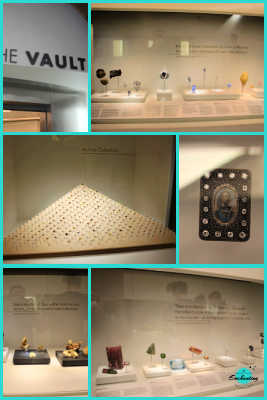
Adjacent to this gallery, you’ll find the Nature’s Treasure House, which contains a stunning array of unique specimens. At the entrance, you’ll spot the most popular western lowland gorilla. The gallery features original images from John James Audubon’s Birds of America book, Sir Hans Sloane’s beautifully carved nautilus shell, an emperor penguin egg collected during Robert Falcon Scott’s Antarctic expedition, a dodo, a first edition of Darwin’s On the Origin of Species, Darwin’s pigeons, beautiful butterflies collected by Alfred Russel Wallace, Blaschka glass models of marine invertebrates, and the fossil Iguanodonbone described by Richard Owen in the paper where he coined the term dinosaur.
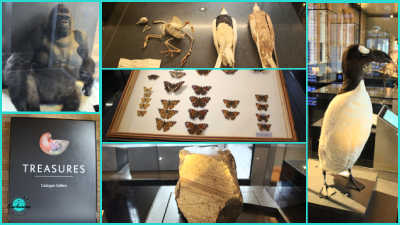
You can also take a look at the Darwin collection at the huge Darwin Centre gallery.

The last gallery in the Green Zone is the Fossils from Britain, wherein you can take a closer look at the specimens discovered from Britain’s age of mammals 65 million years ago. You can view the preserved shark teeth and see examples of fake fossils often mistaken for the real thing.
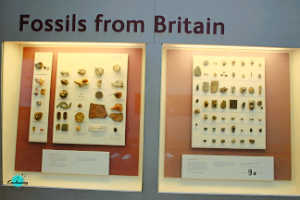
ALSO READ: 11 best important travel safety tips you must know!
Adjacent to it, the Blue zone features Dinosaurs, mammals, fishes, and marine invertebrates. The Blue Zone gallery includes – Jerwood Gallery, Mammals (Blue whale skeleton, antler & rhino), Dinosaurs, Fishes, Amphibians & reptiles, Images of Nature, Mammals and Marine invertebrates.
Let’s start with my favorite Dinosaur gallery for the Blue Zone! Natural History Museum’s Dinosaurs are world-famous, especially T-Rex & Dippy. This gallery features the roaring animatronic T. rex, the first skeleton of Iguanodon, the skull of a plant-eating Triceratops, the gigantic armored dinosaur Scolosaurus, and other fossils.

Since everyone enjoys interactive displays and Dinosaur, we felt that T.Rex & Dinosaur galleries could be a bit brighter and more spacious!
The next Mammals gallery is housed in the huge Hintze Hall, where you’ll come across stunning displays like the extinct mammoth, a musk ox, a giraffe, find out the difference between antlers and horns, giant elk and their relatives, etc. This hall is located right in the middle of the museum.
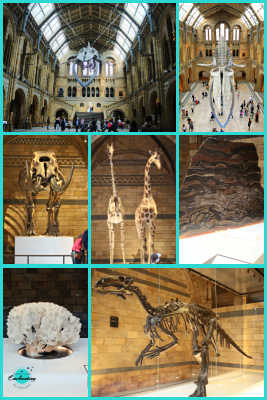
This is the hall where we walked beneath the giant magnificent Blue Whale skeleton (HOPE), the largest animal on earth. The statue of Darwin is also placed in this hall.
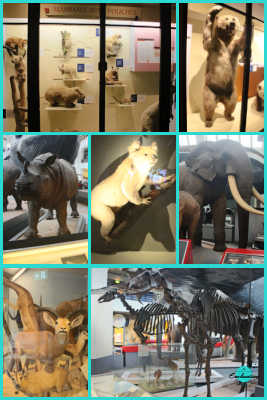
The huge Mammal gallery features a rich diversity of mammals and fossils of the world’s extinct animals. You’ll see the extinct giant Diprotodon from Australia, Cynognathus, the ancient mammal predecessor with reptile features, wild dogs and cats, extinct saber-toothed cats, mammals with pouches, and those without teeth, the unique duck-billed platypus exhibits in this gallery.

The central cafe is located right behind Hintze Hall. If you want to grab some sandwiches, baguettes, and hot & cold drinks, this cafe is great! Adjacent to it, the Images of Nature gallery is located.
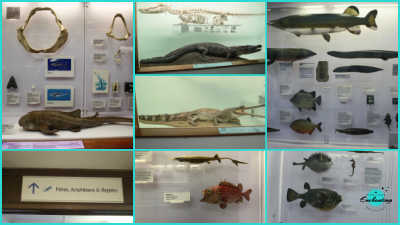
Next gallery is the Fishes, Amphibians & Reptiles gallery, wherein you’ll see the Indian Python’s backbone, angler fish, the jaw of a tiger shark, a furry frog, and another that carries its babies on its back, etc.

In the Marine Invertebrate gallery, you’ll find unique ocean inhabitants exhibits like a crab, spiders, starfish, corals and mollusks, sea snails used to make purple dye, shells once used as currency, snake arms, and basket stars, etc.
ALSO READ: 6 Best National Parks in the UK to Visit This Summer
The last zone (or you can say the first zone if you enter via the Queen’s Gate entrance) is the Orange Zone, which is all about nature. It is comprised of galleries like Attenborough Studio, Wildlife Garden (entrance outside), Zoology Spirit building, and Cocoon (it was closed during our visit).
On the day of our visit, the Attenborough Studio was closed. The museum management hosts various scientist-led talks, free Nature Live talks, and other interesting events at the studio.
We could not visit the Cocoon and Zoology Spirit building, too! So, we headed straight toward the Wildlife garden to see the British flora and fauna. I must admit that we were not impressed!

However, the museum courtyard is beautiful. Post your museum visit, you can relax in this open space.

I also liked the interior design of this museum, which depicts animals among foliage. The museum’s main hall ceiling is designed with hand-painted panels. Some columns have animal sculptures and illustrations, which is pretty impressive. In every corner of this museum, you’ll come across some stunning displays, like birds or hand-painted illustrations.

The Natural History Museum of London is giant in size and has several captivating displays for all ages. Hence, it will take at least 5-6 hours to explore this place, especially if you are a content creator or an avid museum lover who loves to read every specimen of information. From managed shops, cafes, and a prayer room to open relaxation space, the museum has it all!
Entry to the museum is FREE, and you can stay there for as long as you wish until closing time. Isn’t it great?
ALSO READ: Winter wonderlands in the world to experience the best of snow
Best Things To See When You Don’t Have Much Time:
Well, the Natural History Museum has a plethora of attractions for families. Therefore, it completely depends on your interest! You’ll have to decide what you want to see first, especially if you are coming with your kid to this museum. I advise you to start from the top (red zone) Earth Gallery since it has some interesting and interactive volcanic & earthquake-related exhibits.
If you don’t have much time, visit the main Hintze hall first, which features a Blue Whale skeleton hanging from the top roof and other extinct mammals. The best galleries you must check out at the Natural History Museum London are the Blue Zone mammal gallery, dinosaur gallery (T.Rex), birds gallery, fish and Reptiles gallery, Darwin Gallery, Minerals gallery, and Volcanoes and earthquake gallery. You can also take specific trail tours hosted by the museum. Kindly check all the details on the official website before pre-booking your time slot.
Is it worth visiting the Natural History Museum London?
Yes, of course! I highly recommend this free, family-friendly museum to everyone.
YOU MAY ALSO ENJOY READING THESE POSTS ⬇️
- My journey from London, UK to India
- Hotel Suresh Inn Review, Magarpatta, Pune, India
- 10 Reasons To Choose Train Travel Over Car Travel
- Safari Spots In India That Are Worth Visiting
- The essential travelling tips you’ll ever need
- How is travel essential to wellbeing?
- Things to know before visiting the Sheikh Zayed Grand Mosque, Abu Dhabi
- Beginner Ski Resorts: Where To Go And What To Expect
- 7 Best Places To Visit In The UK In Spring 2023
- A Visit To The World’s Tallest Building, Burj Khalifa, Dubai Tips
- Ayodhya travel tips, A Day Trip From Lucknow
- Park Rotana Hotel, Abu Dhabi Review
- What are the best travel-friendly fabrics to wear in cold weather
- Get these 10 Best Presents For Your Valentine (Gift Guide for her)
- How to Protect Your Hair While Traveling
- New Simple Kind To Skin Moisturising Facial Wash Review
- Willen Lake Trip + What I wore to the Lake, Milton Keynes
- Gulliver’s Land of Lights Lantern Festival 2023 Milton Keynes
- An Ultimate Guide to Indian Cuisine
I hope you find this visitor’s guide to Natural History Museum London helpful and informative.
Have you been to the Natural History Museum, UK? If yes, please share your experience with me in the comment section below.




They have some absolutely amazing exhibits there. I’d love to see the T-rex.
I had no idea this museum existed. It looks so interesting. I think I need to plan another trip to London soon.
I have always wanted to visit the place at least once. Hopefully I will be able to do so next year when I fly over!
I love history museums, last time I was in London due to time crunch missed visiting there, this guide is really going to help me out this year end. The list is perfect, I’d know what not to miss out!
We just went to the Natural History Museum in NYC, so it is interesting to read about the London location. These are great tips to be prepared for your visit.
I haven’t been to the museum in a very long time. I’d love to visit this one but it’s a bit far away.
That’s wonderful that all of these fascinating displays are available for the general public to be able to view for free, reserving a time spot is such a small price to pay!
will definitely keep this in mind for my future visit to london
Thank you for these tips! I ‘ve heard so many beautiful things about London Natural History Museum. I am going to visit it one day!
We’ve been to several museums and the experience had always been fascinating. I hope I get to visit that one someday, too.
Thanks for sharing this helpful guide on how to get to the Natural History Museum in London! Navigating the city can be a bit daunting, so having clear directions and transportation options is greatly appreciated. Looking forward to exploring the museum soon!
The Museum looks amazing. I bookmarked to check it out when I go to London!
How cool is it that it is free! We are homeschoolers so free visits like this are always welcome.
I am glad to hear about it! I appreciate the tips you’ve shared and found them helpful! One of my dream destinations is London.
Ohh I missed out this museum during my last trip to London, saved this, so I can visit it with your detailed guide next time. Cheers SiennyLovesDrawing